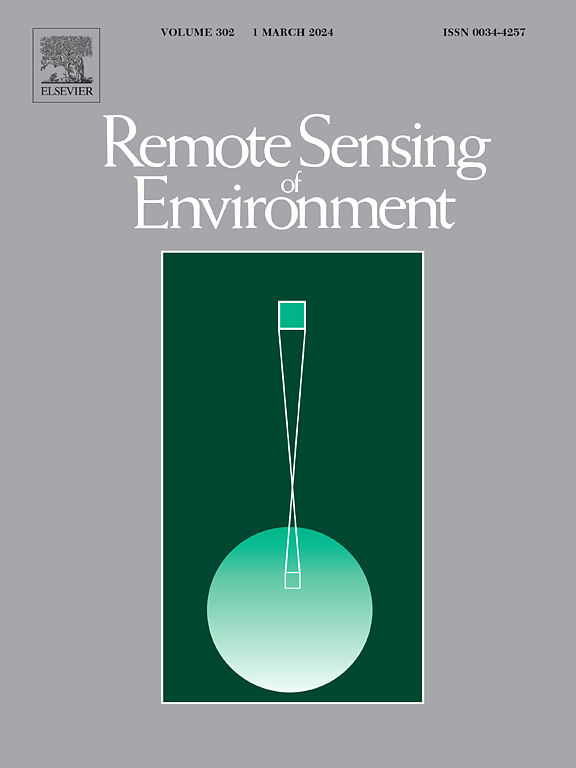Challenges in remote sensing of night lights – a research agenda for the next decade
IF 11.1
1区 地球科学
Q1 ENVIRONMENTAL SCIENCES
引用次数: 0
Abstract
In recent years new sensors and products have been developed to advance our capabilities in assessing human activities based on the remote sensing of night lights. Correctly understanding patterns in human activity and land use based on night lights, is key to gauge our advancement in reaching the United Nations Sustainable Development Goals. In this paper I focus on five challenges in remote sensing of night lights. For each of these research challenges I provide a brief review of previous work, and then demonstrate how this challenge can be tackled, using a variety of ground-based sensors (TESS-4C, LANcube, SVC-HR1024 field spectrometer and webcams), UAV imagery, and spaceborne sensors (SDGSAT-1 and VIIRS/DNB). Challenge 1: Providing a cloud mask in future night light missions; Here I demonstrate that using a thermal night time image acquired simultaneously with the night time light image (as in the case for some of the SDGSAT-1 images), a cloud mask can be created, allowing to analyze night lights over cloud-free areas. Challenge 2: Monitoring hourly changes in night lights over a single night. Here I demonstrated that using mobile measurements conducted with a LANcube photometer at different hours, it was possible to detect locations where and when night lights have decreased during the night (e.g. a large sport stadium). In addition, using a citizen science webcam, I showed that hourly changes in night lights can be discerned even from a non-calibrated camera, and that within the city of Jerusalem, where there is a large population of orthodox Jews, certain land uses had less lights during holy days. Challenge 3: Fusing night time imagery from spaceborne sensors with different overpass times and spatial resolution to better understand hourly changes in night lights; merging SDGSAT-1 images (21:30 overpass) and VIIRS/DNB images (01:30 overpass) I was able to map the turning off of street lights across rural areas in France that accelerated since the 2022 energy crisis of Europe. Challenge 4: Estimating the emissions of blue light using night light sensors; here I demonstrated that the measured portion of blue light varies between ground based and spaceborne sensors, and that it is affected by atmospheric scattering; Challenge 5: Quantifying the anisotropy of night light emissions; here I demonstrated that using panoramic images acquired from a UAV at different heights, it is possible to examine how viewing angles affect the light sources that are observed. I conclude that while the number of designated night lights sensors is still limited, with the availability of new multispectral sensors, we can advance in our understanding of the dynamics of human activities at night-time, by fusing data from different sensors, to take advantage of the unique spatial, spectral, temporal and directional capabilities of each of them.
夜间灯光遥感的挑战——未来十年的研究议程
近年来,新的传感器和产品已经开发出来,以提高我们基于夜间灯光遥感评估人类活动的能力。正确理解基于夜间灯光的人类活动和土地利用模式,是衡量我们在实现联合国可持续发展目标方面取得进展的关键。本文重点研究了夜间灯光遥感面临的五大挑战。对于这些研究挑战中的每一个,我都简要回顾了以前的工作,然后展示了如何使用各种地面传感器(TESS-4C, LANcube, SVC-HR1024现场光谱仪和网络摄像头),无人机图像和星载传感器(SDGSAT-1和VIIRS/DNB)来解决这一挑战。挑战一:在未来的夜间照明任务中提供云罩;在这里,我演示了使用与夜间灯光图像同时获取的夜间热图像(如SDGSAT-1图像的一些情况),可以创建云掩模,从而分析无云区域的夜间灯光。挑战二:监测夜间灯光每小时的变化。在这里,我演示了使用LANcube光度计在不同时间进行的移动测量,可以检测夜间灯光在夜间减少的位置和时间(例如大型体育场)。此外,我还使用了一个公民科学网络摄像头,展示了夜间灯光每小时的变化,即使是没有校准的摄像头也能分辨出来。此外,在拥有大量正统犹太人的耶路撒冷城内,某些土地用途在圣日期间灯光较少。挑战三:融合来自不同立交桥时间和空间分辨率的星载传感器的夜间图像,以更好地了解夜间灯光的每小时变化;结合SDGSAT-1图像(21:30立交桥)和VIIRS/DNB图像(01:30立交桥),我能够绘制出自2022年欧洲能源危机以来加速关闭法国农村地区路灯的地图。挑战4:利用夜光传感器估算蓝光的辐射;在这里,我证明了蓝光的测量部分在地面和空间传感器之间是不同的,并且它受到大气散射的影响;挑战5:量化夜间光发射的各向异性;在这里,我展示了使用从不同高度的无人机获取的全景图像,可以检查视角如何影响观察到的光源。我的结论是,虽然指定的夜灯传感器的数量仍然有限,但随着新的多光谱传感器的可用性,我们可以通过融合来自不同传感器的数据,利用每个传感器独特的空间、光谱、时间和方向能力,来提高我们对夜间人类活动动态的理解。
本文章由计算机程序翻译,如有差异,请以英文原文为准。
求助全文
约1分钟内获得全文
求助全文
来源期刊

Remote Sensing of Environment
环境科学-成像科学与照相技术
CiteScore
25.10
自引率
8.90%
发文量
455
审稿时长
53 days
期刊介绍:
Remote Sensing of Environment (RSE) serves the Earth observation community by disseminating results on the theory, science, applications, and technology that contribute to advancing the field of remote sensing. With a thoroughly interdisciplinary approach, RSE encompasses terrestrial, oceanic, and atmospheric sensing.
The journal emphasizes biophysical and quantitative approaches to remote sensing at local to global scales, covering a diverse range of applications and techniques.
RSE serves as a vital platform for the exchange of knowledge and advancements in the dynamic field of remote sensing.
 求助内容:
求助内容: 应助结果提醒方式:
应助结果提醒方式:


